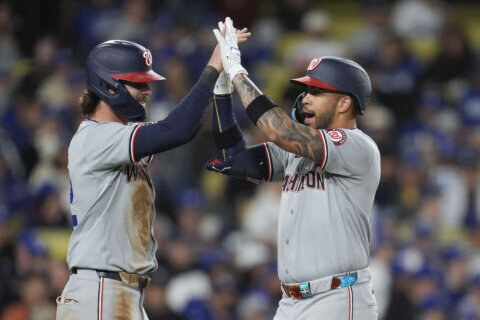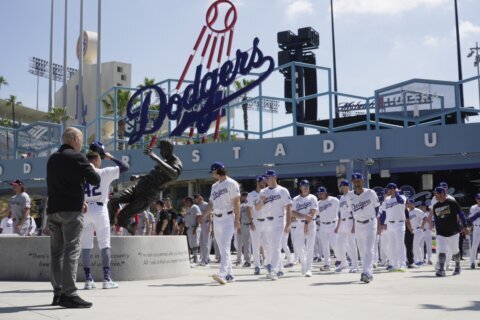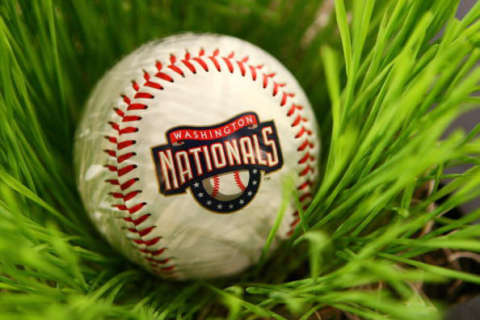WASHINGTON — With two division titles in the past three seasons and a stable of good, young players on the roster, life looks pretty good for the Washington Nationals at first glance. But a deeper look at the organization’s recent front office moves, swelling financial commitments and an uncertain revenue stream suggest a club at a crossroads, with major decisions to make this offseason.
The unpublicized promotion of a senior accounting director to the position of assistant general manager and vice president of finance in the baseball operations department was the first red flag. While General Manager Mike Rizzo downplayed the importance of the move, Adam Kilgore of the Washington Post reported that multiple Nationals baseball personnel viewed the move as odd and out of step with the rest of Major League Baseball. According to that article, one unnamed employee said Ted Towne was viewed as “an unwelcome outsider.”
Immediately after the season, Assistant General Manager Bryan Minniti left the organization, saying it was “time for a change.” He quickly signed on in a similar role with the Arizona Diamondbacks. Meanwhile, though the Nationals have announced the hiring of a new assistant GM and other baseball operation roles, they have dismissed a handful of higher level executives across several departments across the organization.
A Nationals official says the moves have not reduced the team’s business-side payroll so much as a dollar, but would not comment on specific personnel decisions.
These types of restructuring strategies can be troubling for a fan base on a couple of levels. The first is the lack of continuity among those in the front office who deal directly with season ticket holders. The second and more widespread issue is the appearance of scaling back financial resources across the organization, and how that might affect the team on the field, especially given public comments regarding spending and the now-public negotiations with broadcast partner MASN.
The Nationals have seen their on-field payroll more than double from $68 million in 2011 to nearly $137 million in 2014, rising by 39.6 percent, 27.8 percent, and 15.7 percent per year over three consecutive years. Compare that to the rest of the division, where the Braves’ payroll has gone up 23.0 percent and the Phillies’ 7.1 percent, while the Marlins (20.6 percent) and Mets (30.5 percent) have actually slashed their player salaries.
The Nats have had the highest percentage payroll increase in the National League over the past three years — even greater than the free-spending Dodgers, up 91.5 percent from 2011 (the only team with a higher percentage increase is the Kansas City Royals, who slashed payroll from $75 million to $38 million in 2011 before reestablishing a higher baseline the next season).

While it’s true that Ted Lerner has the second-deepest pockets of all major league owners, he didn’t get there by running the real estate business that netted him his fortune at a loss. With the MASN television deal still up in the air and looking ever more likely to tilt in favor of the Orioles, the rapid increase in payroll spending could come grinding to a halt. The Nationals have been hoping for an increase in revenue from MASN to the tune of $100-$120 million a year, up from their current take of roughly $30 million.
According to a ruling made by the Major League Baseball arbitration panel back in June, MASN would owe the Nats just shy of $300 million over five years, backdating to 2012. But that decision has been blocked in court for now via an injunction, and the two sides are scheduled to meet Dec. 15 for a hearing. That timing is unfortunate in regards to the baseball calendar, though — it comes immediately after the Winter Meetings, the biggest off-season transaction point on the baseball calendar.
Fans will likely remember that the Nationals signed Jayson Werth during the 2011 Winter Meetings. If they are to make a major move to improve their roster for next year — or for the long-term future — it could be crucial to know their financial state heading into that week.
The case for next year
As Nats fans know, the club’s contention window is fully open. But they are facing the expiring contracts of Ian Desmond, Doug Fister, Denard Span and Jordan Zimmermann at the end of the 2015 season. They need a more productive solution at second base, but there are few other holes on the roster. In a vacuum, 2015 seems like a great time to push all-in, no matter whether they are able to re-sign any of their impending free agents.
Rizzo has lamented in the past that the team’s success hampers his ability to acquire the type of top talent in the draft that has led them to this point. By making qualifying offers to whichever of the trio of Desmond, Fister and Zimmermann they are unable to sign to an extension, the Nationals will virtually assure themselves of a stockpiled draft in 2016. But that means accepting the possibility of a setback for a couple years after 2015.
The case for the future
The Nationals already owe nearly $96 million in salary commitments to just nine players on their roster for next season. Based on similar comparisons, we can reasonably assume they’ll owe roughly the following amounts to the following arbitration eligible players:

Tyler Clippard: $8 million
Doug Fister: $11 million
Stephen Strasburg: $8 million
Drew Storen: $5 million
Ross Detwiler: $4 million
Craig Stammen: $2 million
Wilson Ramos: $3 million
Jerry Blevins: $2 million
Jose Lobaton: $1 million
Danny Espinosa: $1 million
Ryan Mattheus: $1 million
That’s an additional $46 million to go along with what they’ll owe Anthony Rendon (what looks to be $1.8 million on a contract option) and the collection of other pre-arbitration eligible guys, including Tanner Roark. This pushes the payroll past last year’s mark, without accounting for a solution at second base. Considering that principal owner Mark Lerner called last year’s payroll “beyond topped out,” there’s reason to believe some moves need to be made. And when you consider that Bryce Harper will hit arbitration in 2016, then Rendon and Strasburg in 2017, there will be heavy bills to pay in the future.
By trading some of their high-value assets now, the Nats could free up payroll while also addressing weaknesses at the major league level and in system depth. The two strongest positions in the organization are at starting pitcher and center field. And one could argue that the value for Jordan Zimmermann and Denard Span has never been higher than it is right now.
The pair is owed a combined $25.5 million in 2015, but arguably each is being paid less than open-market value for what they provide at their position. A team with a need for a short-term fix in center field (Giants? Tigers?) would love a piece like Span to help cover ground in a large outfield. But at age 31 by Opening Day, Span’s legs — easily his most valuable asset — are on the decline. His defensive metrics took a hit last year, and history suggests that players of his ilk, such as Michael Bourn and B.J. Upton, are poised for a drop- off in production. With Michael Taylor and Steven Souza Jr. having nothing left to prove at the minor league level, the club could carry both at league minimum salary and let them battle for the starting job, giving the other the final outfielder role off the bench alongside Nate McLouth.
Zimmermann, meanwhile, would be one of the most coveted starters on the market, perhaps ahead of James Shields and Jon Lester. But with one Tommy John surgery already in the rear-view mirror, and the right- hander not expected to give Washington any kind of hometown discount when he enters his age-30 season in free agency, the financial investment to keep him seems to outweigh his potential production. Moreover, the considerable starting pitching depth in the minors — from Lucas Giolito to Taylor Hill to A.J. Cole to Blake Treinen to Austin Voth — means a bevy of strong young arms is on the way. Compare that to the dearth of viable shortstops behind Ian Desmond, and he looks to be a better candidate to extend, both in terms of value to the organization and reduced risk of injury.
Zimmermann could fetch a solid haul of both major and minor league parts, including a potential solution at second base (the Angels’ Howie Kendrick? The Rays’ Ben Zobrist in a multi-team trade?) to help the team compete next year, while bridging the gap to the next set of prospects competing for the job in 2016 and beyond.
Whichever way the Nationals decide to go, the organization will have to make some tough decisions about their financial future, and they may have to do so before they even really have an idea of what that future will hold.
Follow @WTOP and @WTOPSports on Twitter and WTOP on Facebook.







